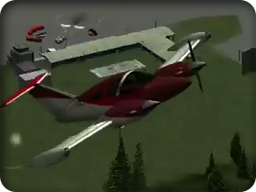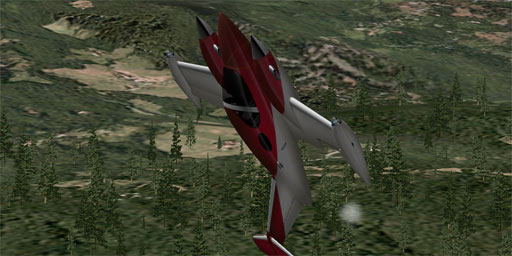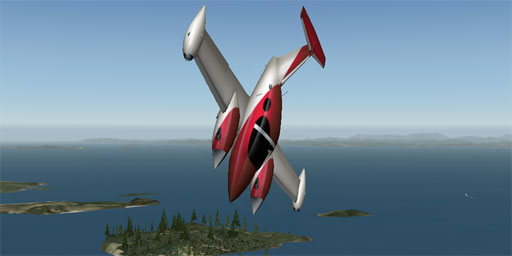I had to do my multiengine training, after stepping into a fairly sweet pile of doodoo... I am now right seat in two king airs, and a Piaggio Avanti, and could not log some of the time due to the lack of rating
MultiEngine Training, Piper Seminole! Thank You!
4 posts
• Page 1 of 1
MultiEngine Training, Piper Seminole! Thank You!
So,
I had to do my multiengine training, after stepping into a fairly sweet pile of doodoo... I am now right seat in two king airs, and a Piaggio Avanti, and could not log some of the time due to the lack of rating . So with that I scrambled to do it hastily so as to start logging all of this very valuable time. I knew that I would be using a seminole for my training, so I quickly purchased another fine set of aircraft from the folks, and in short order, I was practicing in X-Plane. On top of learning some procedural stuff, I also used the visual flight dynamics to learn about the aerodynamic factors involved in one dead engine.
. So with that I scrambled to do it hastily so as to start logging all of this very valuable time. I knew that I would be using a seminole for my training, so I quickly purchased another fine set of aircraft from the folks, and in short order, I was practicing in X-Plane. On top of learning some procedural stuff, I also used the visual flight dynamics to learn about the aerodynamic factors involved in one dead engine.
I had to do my multiengine training, after stepping into a fairly sweet pile of doodoo... I am now right seat in two king airs, and a Piaggio Avanti, and could not log some of the time due to the lack of rating
- digduggy
- Posts: 1
Re: MultiEngine Training, Piper Seminole! Thank You!
Great, and congratulations. That's what it's all about.
Here’s to the crazy ones. The rebels. The troublemakers. The ones who see things differently.
While some may see them as the crazy ones, we see genius.
Because the people who are crazy enough to think they can change the world, are the ones who do.
While some may see them as the crazy ones, we see genius.
Because the people who are crazy enough to think they can change the world, are the ones who do.
-

AADX - Administrator
- Posts: 3842
- Location: Wichita, Kansas
Re: MultiEngine Training, Piper Seminole! Thank You!
AADX BEECH X JOKER IX: Port Hardy BC IP

Oftentimes too many people take for granted the sheer danger that a twin engine aircraft, flying on one engine poses. Too often, two engines is better than one (and one is better than none), and a false sense of security to believe that should one fail, the safety of one good engine will ensure a safe return. This demonstration shows, in extreme, amusing, entertaining and exacerbated form, what one engine operation of a twin can do. Be amused and entertained at the video, and instill a little extra fear into yourself for your own twin engine aircraft operation, that these things can happen to any twin. Awareness is the key to prevention.
I heard just one too many stories by a CFII MEI about twin engine crashes as a result of high power operation and getting behind the ball. In any twin flying on one engine, speed = life. Loose the former, loose the latter. Blue Line (Vyse) and Red Line (Vmc) are the most important thing in your world at that moment in time, should the needle get below them, getting it back above will be difficult, up to impossible, and sometimes not prior to your uncontrolled contact with terrain. Why so grim, What's up with the dark topic Jason?. Well In all twin engine aircraft operation, it can be immensely enjoyable, the power, the thrill, the performance of two engines. The grade of knowledge, skill, and pilot performance to operate a twin engine aircraft, and the 2x power they provide over common Ga singles they may be similar to. However, when taken for granted, and when not treated as absolutely seriously as they can be, when one engine goes down.. you have a tiger by the tail that will eat you alive before you're even aware of what is happening.
One lesson to learn about light GA twins, can be explored in the Seminole. Namely that two engines does not sustainable flight make when one quits. The Seminole has a single engine service ceiling of only 3800' MSL. Service Ceiling being defined by only 50 fpm climb in the best configuration, flight profile, and ideal conditions. 50 fpm in a limping and difficult to control twin, yet only 3800' MSL. I bet we all can think of countless airports that we love, fly out of, are interesting destinations where the field elevation is 2500, 2800, 3200.. or even 3900' MSL. Sedona AZ is 4800', Flagstaff or Prescott AZ are well above 5500', how about Tuscon that is low desert.. still at 2400'. All of that loosely translates to in a Seminole, with an engine failure right after takeoff, you'll be LUCKY to setup and properly fly on one engine, to pattern altitude, to turn around and make it back to the same airport you took off from. In a twin, running the good engine at maximum output, in ideal OEI flight profile. I've heard several stories about (name substituted with "high power twins"), with 300hp/side, engine loss on takeoff, and improper pilot setup and action resulted in the torque and yaw from the good engine at high power, at low speed, literally rolling the plane over into a low altitude aggravated spin. (usually ending terminally and fatally)
So, where does that leave us. Oh yes.. the Joker and some FUN demonstrations, that will shock, amaze, impress, scare, and possibly make you either soil yourself, or shoot something out your nose. Following the UND Aerocast of the Seminole and setting up for and testing for one-engine-off conditions, for better and more fluent operation with one engine down. I'll take this one up to show what the worst and most aggravated forms of the yaw-induced-flat-spin, or yaw + torque induced aggravated spin entry looks like. To do this, I actually designed the AADX Beech X Joker for the express purpose of really LEARNING how these forces act. The Joker with a short overall length, speed tuned vstab (small), ample wingspan which causes the ailerons to be quite a distance out for adverse yaw while trying to retain roll attitude, fuel outboard on tip tanks that dramatically affect roll handling and performance, non-counter-rotating props/engines, and more horsepower per engine than is prudent at 450hp per side on R20 Turbocharged Wankels with 4 blade props.
First I'll do a couple maneuvers and high performance flight with both engines running. To include a hanging-prop tumbling stall ((similar to) Lomcevak), and then a kick-over stall, as well as banks & turns. THEN, to make the points most pronounced, I turn off the fuel to the Critical Engine (p-factor wise) and run the right engine at full-power continuously, except for recovery evolutions. The biggest thing to watch what is happening, is that in a flat, wings-level climb, with eroding speed, the off-center thrust, and high power torque... act against everything you can do....
The AFH describes this (sec 12-27 Engine Inoperative - Loss of Directional Control Demonstration)) as:
While maintaining entry heading, the pitch attitude is slowly increased to decelerate at a rate of 1 knot per second (no faster). As the airplane slows and control effectivity decays, the increasing yawing tendency should be counteracted with additional rudder pressure. Aileron displacement will also increase in order to maintain 5°of bank. An airspeed is soon reached where full right rudder travel and a 5° right bank can no longer counteract the asymmetrical thrust, and the airplane will begin to yaw uncontrollably to the left.
The moment the pilot first recognizes the uncontrollable yaw, or experiences any symptom associated with a stall, the operating engine throttle should be sufficiently retarded to stop the yaw as the pitch attitude is decreased. Recovery is made with a minimum loss of altitude to straight flight on the entry heading at VSSE or VYSE, before setting symmetrical power. The recovery should not be attempted by increasing power on the windmilling engine alone. <snip>
Should a stall occur while the airplane is under asymmetrical power, particularly high asymmetrical power, a spin entry is likely. The yawing moment induced from asymmetrical thrust is little different from that induced by full rudder in an intentional spin in the appropriate model of single-engine airplane. In this case, however, the airplane will depart controlled flight in the direction of the idle engine, not in the direction of the applied rudder. Twins are not required to demonstrate recoveries from spins, and their spin recovery characteristics are generally very poor.
Where VSis encountered at or before VMC, the departure from controlled flight may be quite sudden, with strong yawing and rolling tendencies to the inverted position, and a spin entry. Therefore, during a VMC demonstration, if there are any symptoms of an impending stall such as a stall warning light or horn, airframe or elevator buffet, or rapid decay in control effectiveness, the maneuver should be terminated immediately, the angle of attack reduced as the throttle is retarded, and the airplane returned to the entry airspeed.
For this case I shot multiple angles and a few different takes of some of those events so you can see what happens, how bad (and wickedly entertaining), and how incredibly difficult it is to recover. Dont' give me any BS about it's just the Joker that is hard to recover, the FAA Airplane Flying Handbook section 12-23 covers many points of one engine operation, and to the point of saying multiple times that no twin is spin approved due to the fact that spin recovery is -very-poor-. The AFH Section 12, specifically sec 12-23 is recommended reading for this subject. (per Anthony Bottini, UND)
Reading Topics:
FAA Airplane Flying Handbook - Full PDF
Wikipedia - Critical Engine
Wikipedia - Flat Spin



Oftentimes too many people take for granted the sheer danger that a twin engine aircraft, flying on one engine poses. Too often, two engines is better than one (and one is better than none), and a false sense of security to believe that should one fail, the safety of one good engine will ensure a safe return. This demonstration shows, in extreme, amusing, entertaining and exacerbated form, what one engine operation of a twin can do. Be amused and entertained at the video, and instill a little extra fear into yourself for your own twin engine aircraft operation, that these things can happen to any twin. Awareness is the key to prevention.
I heard just one too many stories by a CFII MEI about twin engine crashes as a result of high power operation and getting behind the ball. In any twin flying on one engine, speed = life. Loose the former, loose the latter. Blue Line (Vyse) and Red Line (Vmc) are the most important thing in your world at that moment in time, should the needle get below them, getting it back above will be difficult, up to impossible, and sometimes not prior to your uncontrolled contact with terrain. Why so grim, What's up with the dark topic Jason?. Well In all twin engine aircraft operation, it can be immensely enjoyable, the power, the thrill, the performance of two engines. The grade of knowledge, skill, and pilot performance to operate a twin engine aircraft, and the 2x power they provide over common Ga singles they may be similar to. However, when taken for granted, and when not treated as absolutely seriously as they can be, when one engine goes down.. you have a tiger by the tail that will eat you alive before you're even aware of what is happening.
One lesson to learn about light GA twins, can be explored in the Seminole. Namely that two engines does not sustainable flight make when one quits. The Seminole has a single engine service ceiling of only 3800' MSL. Service Ceiling being defined by only 50 fpm climb in the best configuration, flight profile, and ideal conditions. 50 fpm in a limping and difficult to control twin, yet only 3800' MSL. I bet we all can think of countless airports that we love, fly out of, are interesting destinations where the field elevation is 2500, 2800, 3200.. or even 3900' MSL. Sedona AZ is 4800', Flagstaff or Prescott AZ are well above 5500', how about Tuscon that is low desert.. still at 2400'. All of that loosely translates to in a Seminole, with an engine failure right after takeoff, you'll be LUCKY to setup and properly fly on one engine, to pattern altitude, to turn around and make it back to the same airport you took off from. In a twin, running the good engine at maximum output, in ideal OEI flight profile. I've heard several stories about (name substituted with "high power twins"), with 300hp/side, engine loss on takeoff, and improper pilot setup and action resulted in the torque and yaw from the good engine at high power, at low speed, literally rolling the plane over into a low altitude aggravated spin. (usually ending terminally and fatally)
So, where does that leave us. Oh yes.. the Joker and some FUN demonstrations, that will shock, amaze, impress, scare, and possibly make you either soil yourself, or shoot something out your nose. Following the UND Aerocast of the Seminole and setting up for and testing for one-engine-off conditions, for better and more fluent operation with one engine down. I'll take this one up to show what the worst and most aggravated forms of the yaw-induced-flat-spin, or yaw + torque induced aggravated spin entry looks like. To do this, I actually designed the AADX Beech X Joker for the express purpose of really LEARNING how these forces act. The Joker with a short overall length, speed tuned vstab (small), ample wingspan which causes the ailerons to be quite a distance out for adverse yaw while trying to retain roll attitude, fuel outboard on tip tanks that dramatically affect roll handling and performance, non-counter-rotating props/engines, and more horsepower per engine than is prudent at 450hp per side on R20 Turbocharged Wankels with 4 blade props.
First I'll do a couple maneuvers and high performance flight with both engines running. To include a hanging-prop tumbling stall ((similar to) Lomcevak), and then a kick-over stall, as well as banks & turns. THEN, to make the points most pronounced, I turn off the fuel to the Critical Engine (p-factor wise) and run the right engine at full-power continuously, except for recovery evolutions. The biggest thing to watch what is happening, is that in a flat, wings-level climb, with eroding speed, the off-center thrust, and high power torque... act against everything you can do....
The AFH describes this (sec 12-27 Engine Inoperative - Loss of Directional Control Demonstration)) as:
While maintaining entry heading, the pitch attitude is slowly increased to decelerate at a rate of 1 knot per second (no faster). As the airplane slows and control effectivity decays, the increasing yawing tendency should be counteracted with additional rudder pressure. Aileron displacement will also increase in order to maintain 5°of bank. An airspeed is soon reached where full right rudder travel and a 5° right bank can no longer counteract the asymmetrical thrust, and the airplane will begin to yaw uncontrollably to the left.
The moment the pilot first recognizes the uncontrollable yaw, or experiences any symptom associated with a stall, the operating engine throttle should be sufficiently retarded to stop the yaw as the pitch attitude is decreased. Recovery is made with a minimum loss of altitude to straight flight on the entry heading at VSSE or VYSE, before setting symmetrical power. The recovery should not be attempted by increasing power on the windmilling engine alone. <snip>
Should a stall occur while the airplane is under asymmetrical power, particularly high asymmetrical power, a spin entry is likely. The yawing moment induced from asymmetrical thrust is little different from that induced by full rudder in an intentional spin in the appropriate model of single-engine airplane. In this case, however, the airplane will depart controlled flight in the direction of the idle engine, not in the direction of the applied rudder. Twins are not required to demonstrate recoveries from spins, and their spin recovery characteristics are generally very poor.
Where VSis encountered at or before VMC, the departure from controlled flight may be quite sudden, with strong yawing and rolling tendencies to the inverted position, and a spin entry. Therefore, during a VMC demonstration, if there are any symptoms of an impending stall such as a stall warning light or horn, airframe or elevator buffet, or rapid decay in control effectiveness, the maneuver should be terminated immediately, the angle of attack reduced as the throttle is retarded, and the airplane returned to the entry airspeed.
For this case I shot multiple angles and a few different takes of some of those events so you can see what happens, how bad (and wickedly entertaining), and how incredibly difficult it is to recover. Dont' give me any BS about it's just the Joker that is hard to recover, the FAA Airplane Flying Handbook section 12-23 covers many points of one engine operation, and to the point of saying multiple times that no twin is spin approved due to the fact that spin recovery is -very-poor-. The AFH Section 12, specifically sec 12-23 is recommended reading for this subject. (per Anthony Bottini, UND)
Reading Topics:
FAA Airplane Flying Handbook - Full PDF
Wikipedia - Critical Engine
Wikipedia - Flat Spin


Here’s to the crazy ones. The rebels. The troublemakers. The ones who see things differently.
While some may see them as the crazy ones, we see genius.
Because the people who are crazy enough to think they can change the world, are the ones who do.
While some may see them as the crazy ones, we see genius.
Because the people who are crazy enough to think they can change the world, are the ones who do.
-

AADX - Administrator
- Posts: 3842
- Location: Wichita, Kansas
Re: MultiEngine Training, Piper Seminole! Thank You!
So instructional yet entertaining Jason! Seriously, one of the best vids I've seen for awhile, and u know I love a good vid! Ok the eyecandy's not there (pm me if u want tips on how to make it better), but I watched enthralled as I saw your smooth handling of her and then those spins! And u recovered so well. Seriously good, I'm posting a link to this for my flightsimulator network buddies, so expect some traffic and accolades. Really interesting background. And so glad u didn't whimp out and made sure u landed. Best 7 minutes of my week.
As contrast, see this vid for great eye/ear candy but awful flying skills. I'm gettin better though, her power is immense and takes some gettin used to.
http://www.youtube.com/watch?v=-1HnB3TPTRk
Simon
As contrast, see this vid for great eye/ear candy but awful flying skills. I'm gettin better though, her power is immense and takes some gettin used to.
http://www.youtube.com/watch?v=-1HnB3TPTRk
Simon
Simon W
Melbourne, Australia
Core i7 920; GTX275
Keyboard; Mouse;
http://www.youtube.com/user/id5556
www.xplane10.wordpress.com
Melbourne, Australia
Core i7 920; GTX275
Keyboard; Mouse;
http://www.youtube.com/user/id5556
www.xplane10.wordpress.com
- capnsully
- Posts: 51
- Location: Melbourne Australia
4 posts
• Page 1 of 1
Who is online
Users browsing this forum: No registered users and 13 guests
